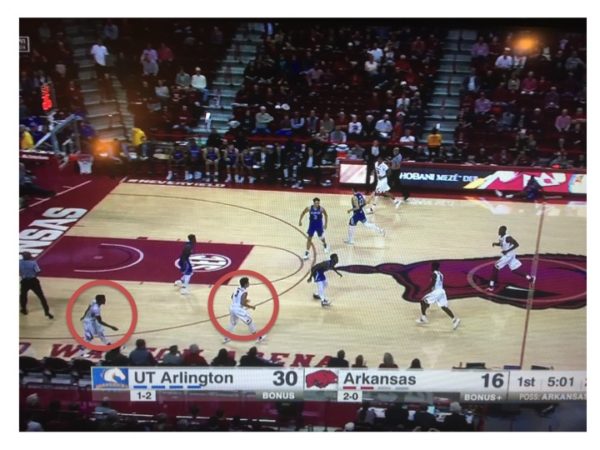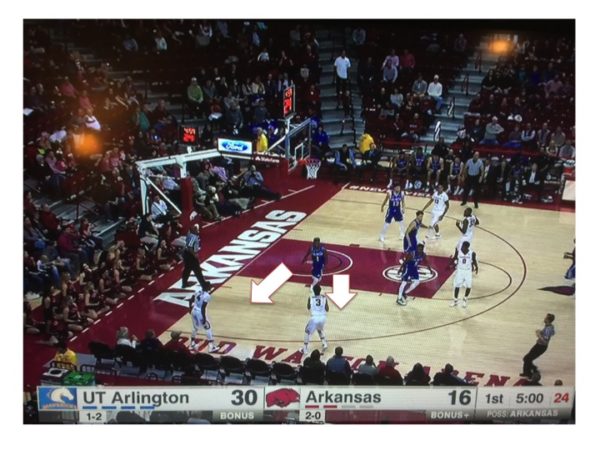Freeze Frame: Arkansas’ Transition Play
Posted by Brian Joyce on November 21st, 2016Arkansas loves to play fast. That statement isn’t exactly newsworthy, but this year’s version of the Razorbacks might be even more effective in the open court than Mike Anderson’s previous squads in Fayetteville. The Razorbacks were tested at home on Friday night in a 71-67 win over Texas-Arlington, and they responded with excellent defense that allowed them to set up the fast break. This also gave us an opportunity to analyze Arkansas’ transition offense in this week’s Freeze Frame.

Arkansas has reduced the number of mid-range jumpers it shoots, in part because of an increase in its transition field goal attempts.
As you can see in the table above, Arkansas’ overall shot selection has improved from a season ago. Contested two-point jump shots are the worst shot in college basketball, and through three games, the Razorbacks have proven far less reliant on the mid-range jumper. A decrease of almost 10 percentage points in attempted twos has resulted in the Razorbacks taking six percent more shots at the rim and a few percentage points more from beyond the three-point arc. This is important because Arkansas is converting over 44 percent of their three-point attempts so far this season. One reason for the bump in offensive efficiency is that Anderson’s team has increased its reliance on transition play from just less than a third (31.3%) of its overall initial field goal attempts last season to 38.9 percent in 2016-17.
Anderson wants to push the tempo as much as possible because this is where his Hogs are most effective. As you can see in the below table that shows the ways in which Arkansas scores in transition, Arkansas has an effective field goal percentage of over 80 percent when it scores within the first 10 seconds of a possession — a mark that ranks sixth in the nation.

The Razorbacks are shooting an incredible 80.7 eFG% in transition play.
One of the reasons Arkansas has been so effective in getting out into the open court is because its offensive players immediately head to the wings and corners to look for open three-pointers. In the below frame you can see Dusty Hannahs and Daryl Macon both lining up behind the arc in anticipation of the outlet pass. Arkansas enjoys a five-on-four break with Moses Kingsley trailing the play.

Arkansas puts two shooters into position to launch the long-range shot.
In the next frame, the Razorbacks overload the left side of the court. Hannahs squares up for the wide open look, and Macon is in the corner if the defender closes out on the ball.

Which path does he choose?
The UT Arlington defender doesn’t have much of a choice here. He tries to close out on the shooter, but Hannahs rises up and knocks down the open three. Kingsley fills in the middle so if the defenders rotate over to defend the long ball, the Hogs can take advantage of their big guy inside.
Arkansas is at its best when it pushes the pace and scores early in the shot clock. The Razorbacks’ overall shot profile is significantly better than a season ago because they have been so effective in transition play, and their elite block (12th nationally) and steal (36th) rates have enabled them to push the pace. If Anderson can coax his offense into a season-long transition rate of nearly 40 percent, Arkansas should be in excellent position to improve considerably on its 16-16 record from last year and make a push back toward the top of the SEC standings.












































